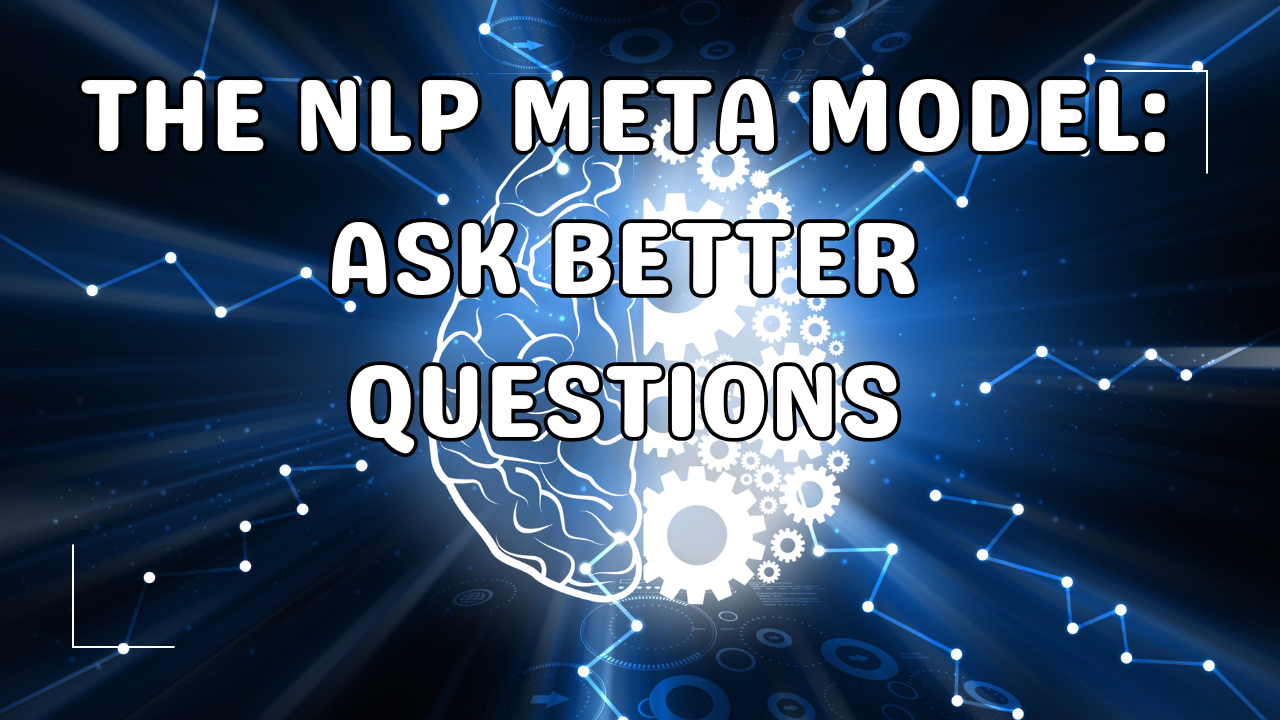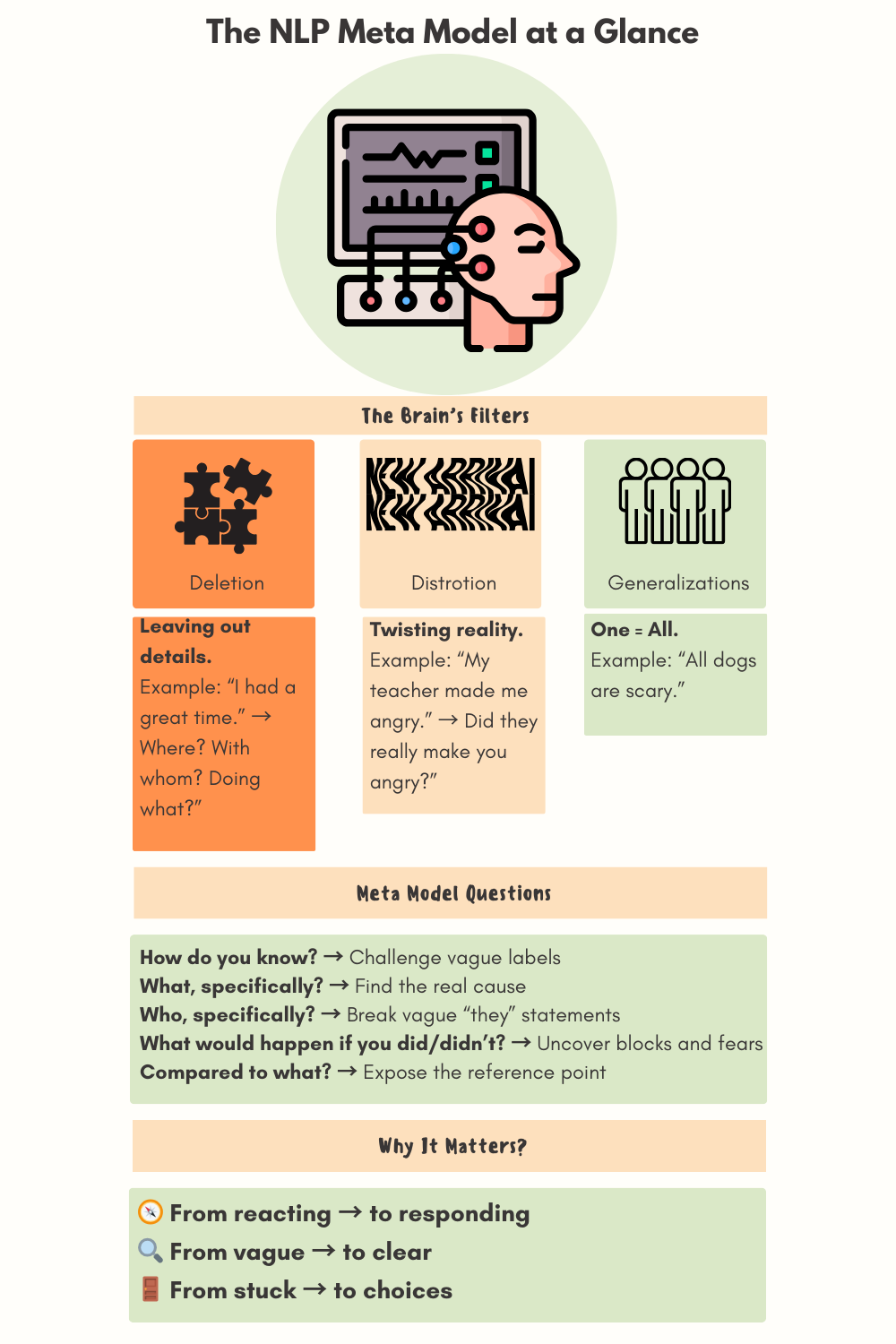
Imagine your brain as a giant, super-fast computer. It’s constantly making up stories and pictures about what’s happening around you and what things mean. These stories form your “map of the world.”
But sometimes, your map isn’t very accurate. Some roads are missing. Others are drawn incorrectly. When that happens, the way you navigate life becomes harder.
This is where the NLP (Neuro-Linguistic Programming) Meta Model comes in. Think of it as a special toolkit for asking questions that make your mental map sharper, clearer, and far more useful.
Deep Structure vs. Surface Structure
Let’s say you have a secret message in your mind. That inner thought — the real, complete idea — is called the deep structure.
But the moment you express it, whether through words or pictures, it becomes the surface structure. Something always gets simplified or left out in that translation.
The Meta Model helps you work backward — from the words someone says (surface structure) to the original, fuller meaning (deep structure).
Example: Writing your name with a pen is surface structure. But the idea of how to write your name is deep structure. You could write it with your hand, your toe, or even holding a pencil in your mouth — because the deep structure is still there.
The Brain’s Three Filters
When turning deep structure into surface structure, our brain runs everything through three filters:
1. Deletion
We leave out details.
“I had a great time.”
But where? With whom? Doing what?
2. Distortion
We twist information.
“My teacher made me angry.”
Did they make you angry, or did you interpret their words that way?
3. Generalization
We take one experience and make it true for all.
“All dogs are scary.”
Based on what? Maybe just one dog barked at you once.
These filters are necessary — they help us process the world quickly. But they can also limit our choices if we don’t question them.
How the Meta Model Helps
The Meta Model gives you precise questions to bring back the missing details, clear up misunderstandings, and sharpen your perspective.
The clearer your mental map, the more choices you have to solve problems and get what you want.
Meta Model Question Examples
Here are a few powerful questions you can use right away:
- “How do you know?”
- If someone says, “I’m a terrible speller,” ask: “How do you know you’re terrible at it?”
This turns a vague label into a real process.
- If someone says, “I’m a terrible speller,” ask: “How do you know you’re terrible at it?”
- “What, specifically?”
- If someone says, “I’m upset,” ask: “What, specifically, are you upset about?”
This pinpoints the true cause.
- If someone says, “I’m upset,” ask: “What, specifically, are you upset about?”
- “Who, specifically?”
- If someone says, “They never listen to me,” ask: “Who, specifically, never listens?”
This breaks the vague “they” into actual people.
- If someone says, “They never listen to me,” ask: “Who, specifically, never listens?”
- “What would happen if you did/didn’t?”
- If someone says, “I can’t get started in the mornings,” ask: “What would happen if you did get started?”
“What stops you from starting?”
This uncovers hidden fears or obstacles.
- If someone says, “I can’t get started in the mornings,” ask: “What would happen if you did get started?”
- “Compared to what/who?”
- If someone says, “This is too hard,” ask: “Too hard compared to what?”
This reveals the frame of reference.
- If someone says, “This is too hard,” ask: “Too hard compared to what?”
Why the Meta Model Matters
- It’s not about asking why someone has a problem.
- It’s about asking how they’re thinking about it — so you can help them think differently.
Think of it like building with Lego. You don’t just admire the finished castle — you need clear instructions. If the instructions are vague, you ask questions until they make sense.
The Meta Model helps people move:
- From reacting → to thinking and planning
- From stuck → to having options
- From one story → to many possible stories
And when you understand how someone “makes sense” of their world, you become a more flexible and effective communicator.
Final Thoughts
The Meta Model isn’t about the story itself — it’s about the structure of thought behind the story.
By asking smarter questions, you get more clarity, more choices, and better solutions.

Download my free Meta Model Quick Reference Sheet here: [Meta-model questions].






